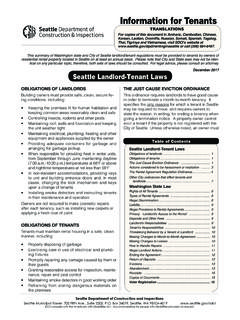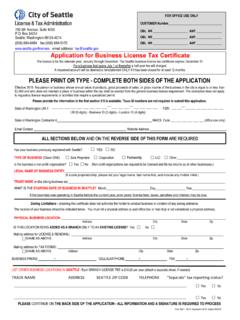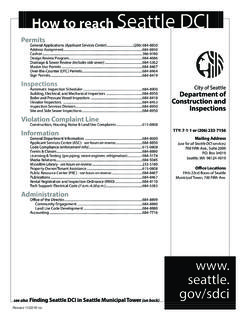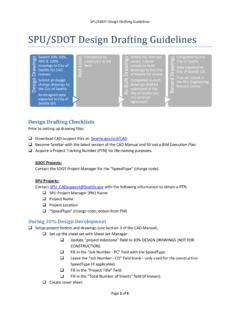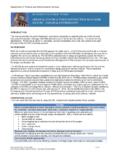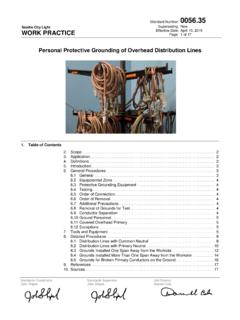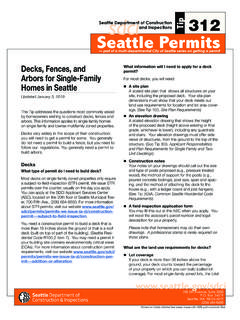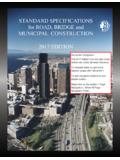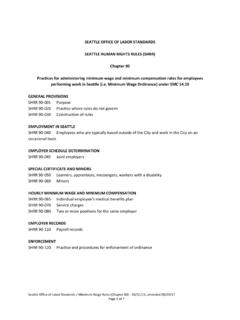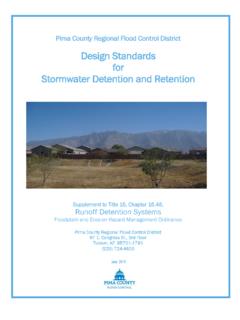Transcription of Seattle SDCI Tip #327A—Environmentally Critical Areas ...
1 5th Avenue, Suite 2000 Box 34019 Seattle , WA 98124-4019 (206) 684-8600 Seattle PermitsTipsdciSeattle Department of Construction and Inspections part of a multi-departmental City of Seattle series on getting a permitPrinted on totally chlorine free paper made with 100% post-consumer fiberEnvironmentally Critical Areas Exemptions, Relief from Pro-hibition on Development, and Modifications to Submittal Requirements Application Instructions and Submittal RequirementsUpdated January 7, 2019 Note: When this Tip refers to ECA regulations that apply within the Shoreline District, please reference ECA regula-tions dated before May 15, 2017. When the Tip refers to ECA regulations that apply outside the Shoreline District, please reference ECA regulations dated May 15, City of Seattle environmentally Critical Areas (ECAs) ordinance (SMC Chapter ) regulates development affecting landslide-prone Areas , steep slope erosion hazard Areas , liquefaction-prone Areas , peat settlement-prone Areas , abandoned landfills, flood-prone Areas , wet-lands, riparian corridors, and other fish and wildlife habitat conservation Areas , and ECA some cases SDCI may allow departures from ECA code requirements.
2 This Tip explains these possibilities, and includes instructions to apply for (1) an exemption to the ECA regulations, (2) other relief from the prohibition on steep slope erosion hazard area development, and (3) modification to submittal considering whether an exemption or relief from steep slope erosion hazard area development standards apply as part of a specific development proposal, SDCI determines whether there is an ECA or ECA buffer on the parcel (SMC ). In some cases, the presence or absence of an ECA can be determined as part of the pre-application site visit (PASV) not, the determination may be made as part of the application process or during the plan review process. You should determine the presence or absence of an ECA as early as possible in the permit process since the presence of ECAs discovered during plan review can result in significant delays or redesign of your project.
3 To determine whether there is an ECA on the parcel, SDCI relies on the definition of the ECA (SMC for projects within the Shoreline District and SMC for projects outside the Shoreline District), maps, site surveys, completed PASV form, topographic maps, technical environmental analysis, and any other information necessary (SMC ). In deter-mining whether there is an ECA buffer on the parcel, SDCI also consults SMC for projects within the Shoreline District and SMC for projects outside the Shoreline District (parcel specific peat settlement-prone area), (wetlands), and (steep slopes) for projects within the Shore-line District and SMC for projects outside the Shoreline District. If there is no ECA or buffer on the site, then exemption from Chapter is not necessary because this chapter applies only to parcels that have ECA Areas or ECA EXEMPTIONSIf granted, an ECA exemption relieves development from many ECA regulations.
4 Standards specified in Section apply and include limits on development, conditions on development, the use of best manage-ment practices, and mitigation of ground disturbance and Critical Areas functions disturbed by development. Other standards also apply, even when an exemption is granted, including the general administrative provi-sions of SMC Section ; how to determine the presence of an ECA and buffer per SMC Section ; and the enforcement provisions of the applications must be part of a specific development proposal (SMC ). Exemp-tions from the ECA standards may be allowed for the 327 ASDCI Tip #327A ECA Exemptions, Relief from Prohibition, Modifications to Submittal Requirements page 2 LEGAL DISCLAIMER: This Tip should not be used as a substitute for codes and regulations.
5 The applicant is responsible for compliance with all code and rule requirements, whether or not described in this (see Section of the ECA regulations for more detailed information):1. Development that does not temporarily or permanently encroach within, alter, or increase the impact to the ECA or buffer on the parcel where the development occurs; but removing existing development and replacing it is not exempt (SMC , for projects within the Shoreline District and SMC for projects outside the Shoreline District).2. Work directly related to ending a condition that is both (1) an immediate threat to the public health, safety and welfare, or creates an immediate risk of damage to public or private property and (2) requires remedial or preventive action in a timeframe too short to allow compliance with the application provisions of this chapter; but the work done must be the minimum needed, the work must comply with the chapter s requirements to the extent practicable and related work after that time period is not exempt (SMC for projects within the Shoreline District and SMC for projects outside the Shore-line District).
6 3. Maintenance, repair, interior renovation, or interior structural alteration, or window, siding or roof re-placement of an existing development. The change to existing development cannot increase the size of the development as determined from the "plan view;" the project does not increase the impact, encroach further within, or further alter an ECA or buffer (SMC ).4. For projects within the Shoreline District: Rebuilding or replacing structures that are destroyed by an act of nature, if replaced to the same footprint and height of the destroyed structure and there is no increase in nonconformity within the ECA regulations is allowed. Work on these structures must be commenced within one year (SMC ) For replacing structures outside the Shoreline Districts see SMC ).
7 5. Certain electric, natural gas, cable communications, telephone, public facility and utility, and right- of-way improvement projects when the project is not a prerequisite to development. This exemption will only be approved when it can be demonstrated that (1) no practicable alternative with less impact exists, (2) the encroachment into a Critical area is minimized to the greatest extent practicable, and (3) mitigation mea-sures are employed before, during and after construc-tion. (SMC and for projects outside the Shoreline District).6. Normal and routine operation, structural mainte-nance, remodeling, repair, and removal of existing public facilities and utilities, when these activities do not result in substantial disturbance or adverse impacts of ECAs or buffers (SMC ).
8 7. Normal and routine (a) pruning, (b) tree and veg- eta-tion maintenance and management, and (c) reveg-etation using native trees and vegetation when they both (1) do not result in substantial disturbance or adverse impacts of environmentally Critical Areas or buffers and (2) are carried out in parks, public utility rights-of-way, and publicly owned open spaces by the public agencies that are responsible for them ( ). Exemptions for some projects, except for those in wet-lands or riparian corridors, may be approved by a per-mit leader or permit specialist at the counter if sufficient information is presented for this determination. Types of exemptions most frequently granted in this way are for routine repair and maintenance of existing struc-tures and correction of emergency conditions.
9 The staff member you speak with will be able to identify requests that trigger the need for a more formal application with documentation for review by the Director. They will also be able to provide you with procedural information about submittal and review of an exemption can obtain ECA information online at (a-z)/environmentally- Critical - Areas -(ec a) FROM PROHIBITION ON STEEP slope EROSION HAZARD AREA DEVELOPMENTThe ECA Code does not allow development in steep slope erosion hazard Areas or steep slope buffers unless you obtain Relief from Prohibition on Steep slope Erosion Hazard Area Development or an ECA Steep slope Erosion Hazard Area Variance. When you apply for Relief from Prohibition on Steep slope Erosion Hazard Area Development (Relief), we decide whether your projects fits one of the following four criteria to obtain Relief as described below (and more completely in SMC for projects within the Shoreline District and SMC for projects outside the Shoreline District):a.
10 When development is located within the footprint of lawfully constructed structures or paved Areas (not including landscaped Areas or Areas that have been graded), if the impact on the steep slope area is not al-SDCI Tip #327A ECA Exemptions, Relief from Prohibition, Modifications to Submittal Requirements page 3 LEGAL DISCLAIMER: This Tip should not be used as a substitute for codes and regulations. The applicant is responsible for compliance with all code and rule requirements, whether or not described in this or increased ( a legal structure in a steep slope area/buffer could be replaced in the same location).b. When development is located on steep slope erosion hazard Areas that have been created through previ-ous legal grading activities, including rockeries or retaining walls resulting from right-of-way improve-ments, if no adverse impact on the steep slope area will result.
